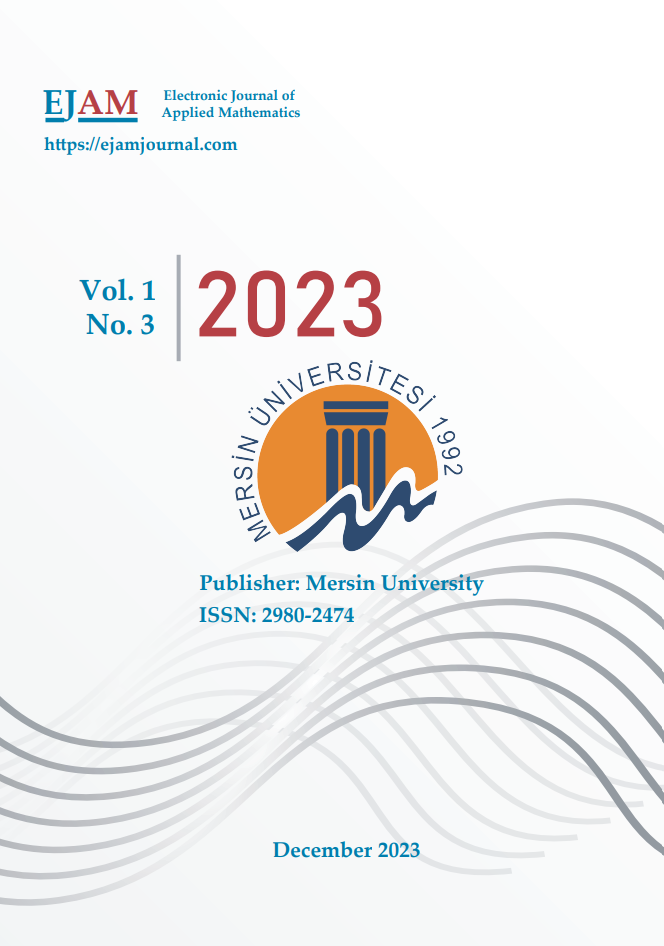Dynamics of a Diffusive Two Predators-One Prey System
DOI:
https://doi.org/10.61383/ejam.20231349Keywords:
Cross-diffusion, Leslie-Gower model, global stability, priori estimates, bifurcationAbstract
This paper analyses a diffusive predator-prey model consisting of a single prey species and two predator species with modified Leslie-Gower term Holling type II functional response subject to the homogeneous Neumann boundary condition. Local stability condition is derived by the application of Routh-Hurwitz criterion. Global asymptotic stability of the unique positive steady state is shown by constructing a suitable Lyapunov function when self diffusion is allowed where as non-constant positive steady states can exist due to the presence of cross-diffusion, that means, cross-diffusion can induce stationary pattern. Taking the cross diffusion as a bifurcation parameter, one can show the existence of positive non-constant solutions with the help of bifurcation theory. A brief conclusion completes the paper.References
[1] A. Korobeinikov, A Lyapunov function for Leslie-Gower predator-prey models. Applied Mathematics Letters, 14 (2001), 697-699. DOI: https://doi.org/10.1016/S0893-9659(01)80029-X
[2] M. A. Aziz-Alaoui, Study of a Leslie-Gower type tritrophic population model. Chaos, Solitons and Fractals. 14 (2002), 1275-1293. DOI: https://doi.org/10.1016/S0960-0779(02)00079-6
[3] Y. Li, D. Xiao, Bifurcation of a predator-prey system of Holling and Leslie type. Chaos, Solitons and Fractals. 34 (2007), 606-620. DOI: https://doi.org/10.1016/j.chaos.2006.03.068
[4] M.A.Aziz-Alaoui, M.D.Okiye, Boundedness and global stability for a predator-prey model with modified Leslie-Gower and Holling type II schemes. 16 (2003) 1069-1075. DOI: https://doi.org/10.1016/S0893-9659(03)90096-6
[5] D. Tong, Y. Cai, B. Wang, W. Wang, Bifurcation structure of non-constant positive steady states for a diffusive predator-prey model. Mathematical Biosciences and Engineering. 16 (2019), 3988-4006. DOI: https://doi.org/10.3934/mbe.2019197
[6] L. Hei, Y. Yu, Non-constant positive steady state of one resource and two consumers model with diffusion. Journal of Mathematical Analysis and Applications, 339 (2008), 566-581. DOI: https://doi.org/10.1016/j.jmaa.2007.06.069
[7] P. Y. H Pang, M. X. Wang, Non-constant positive steady states of a predator-prey system with non-monotonic functional response and diffusion. Proceedings of the London Mathematical Society. 88 (2004), 135-157. DOI: https://doi.org/10.1112/S0024611503014321
[8] W. Ko, K. Ryu, Non-constant positive steady states of a diffusive predator-prey system in homogeneous environment. Journal of Mathematical Analysis and Applications, 327 (2007), 539-549. DOI: https://doi.org/10.1016/j.jmaa.2006.04.077
[9] G. Hu, X. Li, Turing patterns of a predator-prey model with a modified Leslie-Gower term and cross-diffusion. Interna tional Journal of Biomathematics. 5 (2012) article 1250060. DOI: https://doi.org/10.1142/S179352451250060X
[10] H. Qiu and S. Guo, Steady states of a Leslie-Gower model with diffusion and advection. Applied Mathematics and Computation. 346 (2019), 695-709. DOI: https://doi.org/10.1016/j.amc.2018.10.002
[11] S. Djilali, B. Ghanbari, Dynamical behavior of two predators-one prey model with generalized functional response and time-fractional derivative. Advances in Difference Equations. 2021 (2021) 235. DOI: https://doi.org/10.1186/s13662-021-03395-9
[12] M. Mirella Cappelletti, B. Lisena, A diffusive two predators-one prey model on periodically evolving domains. Mathematical Methods in the Applied Sciences. (2021) 1-23.DOI: 10,1002/mma.7323.
[13] D. Luo, Steady state for a predator-prey cross-diffusion system with the Beddington-DeAngelis and Tanner functional response. Boundary Value Problems. (2021) 2021: 4. doi.org/10.1186/s13661-020-10469-3. DOI: https://doi.org/10.1186/s13661-020-01469-3
[14] X. Li, S. Xu. Global solutions for a general predator-prey model with prey-stage structure and cross-diffusion. Filomat 36(2022), 2153-2170. DOI: https://doi.org/10.2298/FIL2207153L
[15] M. Zhu, J. Li, X. Lian, Pattern dynamics of cross diffusion predator-prey system with strong Allee effect and hunting cooperation. Mathematics. 10 (2022), 3171. doi.org/10.3390/math10173171. DOI: https://doi.org/10.3390/math10173171
[16] Y. Yu, Y. Chen, Y. Zhou, Cross-diffusion-induced Turing instability in a two-prey one-predator system. Mathematics. 11 (2023), 2411. doi.org/10.3390/math11112411. DOI: https://doi.org/10.3390/math11112411
[17] A. Turing, The chemical basis of morphogenesis. Philosophical Transactions of Royal Society Series B. 237 (1952), 37-72. DOI: https://doi.org/10.1098/rstb.1952.0012
[18] A. Gierer, H. Meinhardt, A theory of biological pattern formation. Kybernetik. 12(1972), 30-39. DOI: https://doi.org/10.1007/BF00289234
[19] D. Iron, M. J. Ward, J. Wei, The stability of spike solutions to one-dimensional Gierer-Meinhardt model. Physica D. 150 (2001), 25-62. DOI: https://doi.org/10.1016/S0167-2789(00)00206-2
[20] G. M. Liberman, Bounds for steady-state Sel’kov model for arbitrary p in any number of dimensions. SIAM Journal of Mathematical Analysis. 36 (2005), 1400-1406. DOI: https://doi.org/10.1137/S003614100343651X
[21] M. Wang, Non-constant positive steady states of the Sel’kov model. Journal of Differential Equations. 190 (2003), 600-620. DOI: https://doi.org/10.1016/S0022-0396(02)00100-6
[22] X. Zeng, Non-constant positive steady states of a prey-predator system with cross-diffusion. Journal of Mathematical Analysis and Applications, 332 (2007), 989-1009. DOI: https://doi.org/10.1016/j.jmaa.2006.10.075
[23] M. X. Wang, Stationary pattern caused by cross-diffusion for a three species prey-predator model. Computers and Mathematics with Applications. 52 (2006), 707-720. DOI: https://doi.org/10.1016/j.camwa.2006.10.009
[24] W. Chen, R. Peng, Stationary patterns created by cross-diffusion for the competitor-competitor-mutualist model. Journal of Mathematical Analysis and Applications, 291 (2004), 550-564. DOI: https://doi.org/10.1016/j.jmaa.2003.11.015
[25] D. Henry, Geometric Theory of Semilinear Parabolic Equations. vol. 840 of Lecture Notes in Mathematics, Springer, Berlin. Germany, 1981. DOI: https://doi.org/10.1007/BFb0089647
[26] T. Ma, X. Meng, Global analysis and Hopf-bifurcation in a cross-diffusion prey-predator system with fear effect and predator cannibalism. Mathematical Biosciences and Engineering. 19 (2022), 6041-6071. DOI: https://doi.org/10.3934/mbe.2022282
[27] Y. Lou, W. M.Ni,”Diffusion, self-diffusion and cross-diffusion.” Journal of Differential Equations. 131 (1996), 79-131. [28] C. S. Lin, W. M. Ni, I. Takagi, ”Large amplitude stationary solutions to a chemotaxis system”. Journal of Differential Equations. 72 (1988), 1-27. DOI: https://doi.org/10.1006/jdeq.1996.0157
[29] L. Nirenberg, Topics in Nonlinear Functional Analysis. Amer. Math. Soc. Providence 4 (2001). DOI: https://doi.org/10.1090/cln/006
[30] P.Y.HPang,M.X.Wang,Strategyandstationarypatterninathree-species predator-prey model. Journal of Differential Equations. 200 (2004), 245-273. DOI: https://doi.org/10.1016/j.jde.2004.01.004
[31] Y. Li, X. Zhang, B. Liu, Global stability and stationary pattern of a diffusive prey-predator model with modified Leslie-Gower term and Holling II functional response. Journal of Nonlinear Science and Applications. 9 (2016), 2527-2540. DOI: https://doi.org/10.22436/jnsa.009.05.51
Downloads
Published
Issue
Section
License
Copyright (c) 2023 Debasis Mukherjee

This work is licensed under a Creative Commons Attribution 4.0 International License.


